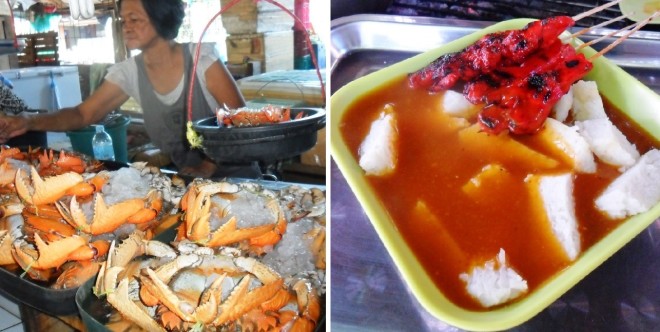
At the next table, a pile of eaten curacha (ranina ranina or red frog crab) gave us more than a hint of what we were going to have for lunch. We were in Zamboanga City to sample its cuisine as part of Flavors of the Philippines—a month-long fiesta showcasing the country’s dishes with regional festivals and market trips.
The flight was delayed and we missed out on the morning trip to the pink beach of Santa Cruz Island—my frustration since I never got to see it in my many previous visits to Zamboanga. But we made it to the other must-visit, Alavar’s, where the curacha is always eaten with the sauce that made the restaurant famous.
The formula is a secret, but a good guess would be crab fat with coconut milk—which explains why you buy a pack of the frozen sauce. To make it last the more than two-hour trip from Zamboanga to Manila, it should be transported in a Styrofoam box together with the curacha bought at Aderes Flea Market in Guiwan.
Low prices
You should make it a point to visit the market to see that seafood sold at such low prices is available in Manila. Apart from curacha, there are plenty of alimasag (blue crabs), lapu-lapu, maya-maya, tambakol (grouper, red snapper, tuna)—many of which are shipped to Manila as can be gleaned from the addresses written on the huge Styrofoam boxes.
The small eateries, or carinderia, provide cooking service, which is advisable if you are bringing any of the crabs and shrimps miles away from Zamboanga.
White shells of imbao, or mangrove shells, cooked with butter and garlic were a welcome sight; they always remind me of excellent food down South. One can never have these in Manila, since they don’t travel well.
Lato, or grape-like clusters of seaweeds, with mangoes had bagon gata as dressing, which is how a mixture of shrimp paste and coconut milk is called at the place.
The main event, Sabores! (meaning flavors), was scheduled in the evening, with a buffet of Zamboanga food prepared by local restaurants.
In the afternoon, guests had a taste of the city’s other specialties. One of them is the rebusao, sliced saging na saba fried with brown sugar coating—such simple cooking but so memorable.
Beside the rebusao stall was a sign in Chabacano, or the local patois of Spanish and Bisaya. It said: “Pabor no buta el basura aqui (Please don’t throw your garbage here).”
‘Mona Lisa’ bread
Told that we were going to a bakery, I thought it would be Myrna’s Bake House, owned by Myrna Innocencio, a first-prize winner in the Maya Cookfest and whose pastries have been part of Zamboanga’s culinary scene for more than 30 years. Instead we visited ABC Bakeshop where the “Mona Lisa” is supposed to be the signature bread, and which looked very much like monay.
Probably due to the unsavory history of the bread’s name (a woman’s private parts), the bakeshop has decided to change it. The guests were served pan de mongo.
Sabores! was held at Paseo del Mar, the seaside boulevard lined with restaurants. Before guests partook of the feast, a program introduced all the influences incorporated in Zamboanga cooking—Malay, Chinese and Spanish.
The Department of Tourism and media members participated in the welcome ceremonies, which included sipping local wine in clay pots using bamboo straws.
The food of Zamboanga includes Muslim specialties, which were represented that evening at the Bay Tal Mal restaurant booth. Three blackened dishes more than hinted of the pamapa itum (spice mix with burnt coconut) used. There was beef piyassak (liver) and tiyulah itum (beef soup)—the stew of beef kulma and the sweets of qui-talam (rice flour with coconut milk and sugar topped with evaporated milk and egg) and ayir bandung (pandan syrup with evaporated milk) .
Alavar’s was also represented with several dishes, though the callos, locally called mindongo de vaca con garbanzos, reminded one of grandmother’s cooking.
Big Dawg’s Bistro likewise had callos, but it was the Paella Chavacana con Imbao y Gambas where the lines were longest.
Chinito’s Restaurant had a twist to the Tausug pianggang manuk (chicken rubbed in spices, boiled then grilled) by having it done as pastel with a cream sauce.
Chowtime offered Filipino favorites like papaitan kambing (goat cooked with bile) and Valenciana picadillo, which is beef bopis with radish.
South Avenue served Asao Trio, grilled fish, chicken and beef with a trio of sauces—sambal Zamboanga, spicy kulma and cawa-cawa sauce.
My vegetarian friend could at least eat food from Planet Vegis, which had tofu sisig, broccoli casserole, vegetable caldereta and cauliflower pakora.
More cooking
I was glad to take a late flight the next day so I could go to market again and sample more cooking. Dennis Coffee Garden was a new experience; it specializes in Tausug cooking in an old house with a garden. We ordered a sampler that included tiyula itum, satti, pianggang manuk, kurma, utak-utak (fried fish cake) and maras with sambal (cucumber with shrimp paste).
While waiting for the food, the resto agreed to give us a demonstration of the satti ayam (chicken sate). Paskal Salimuddin learned how to do the satti from the main cook, who was brought in from Jolo where Dennis Coffee Garden originated. He was taught how to do the skewered chicken or beef pieces, the sauce made red with tomatoes but whose taste resonates with the pamapa itum taken with takmu, the Tausug version of the hanging rice, or puso.
Of course, we also had to have the kahawa sug or coffee, which spawned this eating place from its mother restaurant in Jolo. Founded by the family matriarch, Hajja Ubbaisa Hallul, it is now run by her grandchildren.
E-mail pinoyfood04@yahoo.com